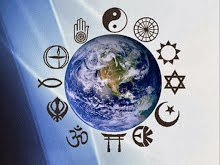Thus, many puranas are there which describes cycles within cycles,well cycle could be understand as units of deva years, each of which equals 360 human years.The following description starts with the smaller cycles and works up to the larger ones. The length of each cycle is given in ordinary human (earth) years, as well other units where appropriate. Large numbers are described using the conventions of American English: thus, a million is a thousand thousand, a billion is a thousand million, a trillion is a thousand billion.
This description is based on numerous sources, which are given in the "References" section at the end of this document.
Maha Yugas-
The smallest cycle is called a maha yuga. A maha yuga is 4,320,000 human years. Each maha yuga is subdivided into the following four ages, whose lengths follow a ratio of 4:3:2:1:
Satya Yuga (also called Krita Yuga)
This first age is 1,728,000 human years. Also known as the
Golden Age or age of Truth. The qualities of this age are: virtue reigns
supreme; human stature is 21 cubits; lifespan is a lakh of years, and death
occurs only when willed.
Treta Yuga
This second age is 1,296,000 human years. Also known as the
Silver Age. The qualities of this age are: the climate is three quarters virtue
and one quarter sin; human stature is 14 cubits; lifespan is 10,000 years.
Dvapara Yuga
This third age is 864,000 human years. Also known as the
Bronze Age. The qualities of this age are: the climate is one half virtue and
one half sin; lifespan is 1,000 years.
Kali Yuga
The fourth and last age is 432,000 human years. Also known
as the Iron Age. This is the age in which we are presently living. The
qualities of this age are: the climate is one quarter virtue and three quarters
sin; human stature is 3.5 cubits; lifespan is 100 or 120 years.
Toward the end of a Kali Yuga, various
calamities cause a good deal of destruction. Baba Hari Dass states that
creation disappears at the end of a Maha Yuga and remains in seed form inside
Brahma. However, other sources do not suggest anything so drastic; it is
possible that Hari Dass was really thinking of the end of Brahma's daytime or
Brahma's life when he wrote this description.
Brahma
Days (Kalpas)
A kalpa is a single daytime period
in the life of Brahma, the creator god. Two kalpas are a day and a night of
Brahma.
Each kalpa is composed of 1,000 maha
yugas. A kalpa is thus equal to 4.32 billion human years.
At the end of Brahma's daytime
period, the Three Worlds (Bhuloka, Bhuvarloka, Swarloka) and the seven
underworlds (of the nagas) are temporarily dissolved (pralaya); that is, the
same folks can be reincarnated when the next day of Brahma begins.
The Vishnu Purana states that at the
end of the daytime period of Brahma, a dreadful drought occurs that lasts 100
years, and all the waters are dried up. The sun changes into seven suns, and
the three worlds (Bhurloka or Earth, Bhuvarloka or the lowest heaven, and
Svarloka or the next higher heaven) and the underworlds are burned bare of
life. The inhabitants of Bhuvarloka and Svarkloka flee to the next higher
heaven, Maharloka, to escape the heat; and then to the next higher heaven,
Janaloka.
Then mighty clouds form and the
three worlds are completely flooded with water. The lord Vishnu reposes on the
waters in meditative rest for another whole kalpa (4.32 billion years) before
renewing the creation.
The destruction that takes place at
the end of a daytime of Brahma is referred to as naimittika, which is
incidental or occasional. The characteristic of this destruction is that the
three worlds continue to exist but are made uninhabitable. The souls of
individuals also continue to exist to be reincarnated in the next daytime of
Brahma.
Brahma Years
FOR PART-1click here
FOR PART- 3 click here
Brahma Years
A year of Brahma is composed of 360
day/night cycles of Brahma, or 720 kalpas, or 8.64 billion human years.
Brahma
Life
The lifespan of Brahma is 100 Brahma
years, or 72,000 kalpas, or 311.04 trillion human years.
At the end of the life of Brahma,
all worlds are completely dissolved (mahapralaya). No one is reincarnated from
these worlds ever again.
Manvantaras
Another cycle that overlaps the others
is that of manvantaras. Each kalpa is reigned over by a succession of 14 Manus,
and the reign of each Manu is called a manvantara. A single manvantara is
approximately 71 maha yugas.
Coomaraswamy states: "Each
Manvantara is followed by a Deluge, which destroys the existings continents and
swallows up all living beings, except the few who are preserved for the
repeopling of the earth."
Our
Position in History
We are located in the fifty-first
Brahma year of the life of our Brahma.
Within that Brahma year, we are in
the first Brahma day, called the Varaha kalpa.
Within that Brahma day, we are in
the seventh manvantara, and in the 28th maha yuga of that manvantara. This
would place us at about the 454th maha yuga of the 1,000 maha yugas that
comprise this day of Brahma.
Within this maha yuga, we are in
Kali Yuga. The 5100th year of Kali Yuga will correspond to the year 2,000 A.D.
That means that we are fairly early in Kali Yuga and this age will continue
more than 426,000 more years.FOR PART-1click here
FOR PART- 3 click here



0 comments:
Post a Comment